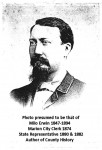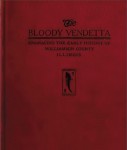Plans Made for Meeting to be Held on July 1
Tentative plans for holding a charter night for the newly organized Marion Junior Chamber of Commerce were discussed at a meeting of the group Thursday evening at the Scout Cabin. Continue reading

Plans Made for Meeting to be Held on July 1
Tentative plans for holding a charter night for the newly organized Marion Junior Chamber of Commerce were discussed at a meeting of the group Thursday evening at the Scout Cabin. Continue reading
Paving Machine Invented in Marion Will Revolutionize the Industry
W.F. “Frankie” Merritt, 428 S. Future Street, Marion, has invented a machine which may revolutionize paving operations in the United States. Merritt, who is chief mechanic for the Regenhardt Construction Company of Cape Girardeau, Missouri, has developed a paving machine which requires no forms, but deposits the fresh concrete directly on the new road, saving approximately ten per cent in the cost of operation, and reducing the number of workers. With a traveling sub-grade machine, the results are practically the same as paving with forms. Continue reading
 Milo Erwin was born October 24, 1847 near the village of Crab Orchard, six miles east of Marion. This area had been settled by people from North Carolina, among them a Revolutionary War ancestor of Milo Erwin.
Milo Erwin was born October 24, 1847 near the village of Crab Orchard, six miles east of Marion. This area had been settled by people from North Carolina, among them a Revolutionary War ancestor of Milo Erwin.
Milo Erwin was the son of Robert P. and Eliza (Furlong) Erwin. Robert P. and his brother-in-law, James M. Furlong, built a steam mill for both grist and lumber at Crab Orchard in 1854; this was the county’s second mill. It was in the center of town and had no doors. Folks who had no desire to pay for grist found it easy to take what they wanted at night; thus the village was nick-named “Steal Easy.” Continue reading
 Milo Erwin was 29 years old when he wrote “The History of Williamson County, Illinois” in 1876. Our country was 100 years old and Williamson County was 37 years old. The Bloody Vendetta was scarcely over and many wounds, no doubt, were fresh. His book had 283 pages and only 123 were used to tell that story; the remaining pages told the history of our county from formation to 1876. Many pages were used to tell of his admiration of the hardy stock that settled here and shaped the history of Williamson County. Continue reading
Milo Erwin was 29 years old when he wrote “The History of Williamson County, Illinois” in 1876. Our country was 100 years old and Williamson County was 37 years old. The Bloody Vendetta was scarcely over and many wounds, no doubt, were fresh. His book had 283 pages and only 123 were used to tell that story; the remaining pages told the history of our county from formation to 1876. Many pages were used to tell of his admiration of the hardy stock that settled here and shaped the history of Williamson County. Continue reading
This report was published in 1914 by R.G. Dun (later to be Dun & Bradstreet). It is titled “Merchants, Tradesman and Manufacturers Financial Condition for Marion, Illinois 1914.” The report lists over 250 Marion merchants and tradesman for that year. If known, it lists their financial strength and gives a credit rating. This guide would have been used to judge whether a businessman would qualify for credit and reflects their financial strength. Continue reading